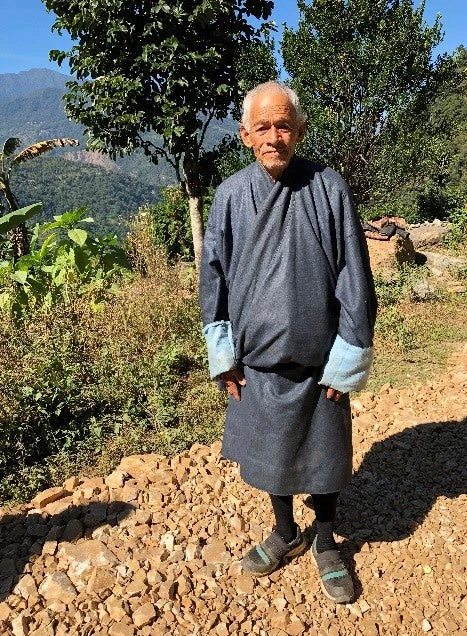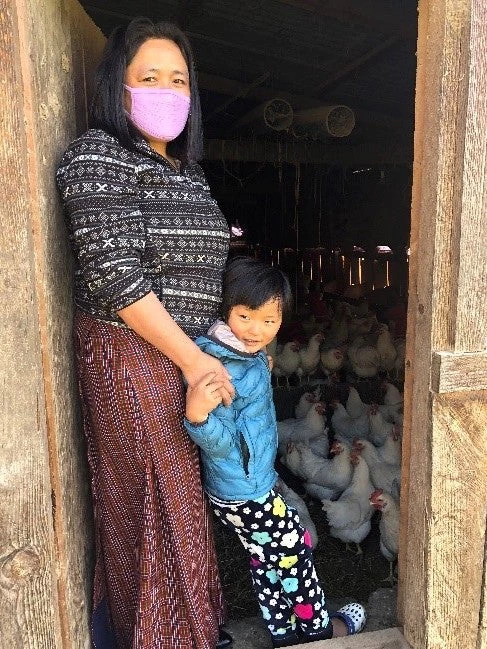
of the Remote Rural Communities
Development Project (RRCDP) in Bhutan.
Photo Credit: Izabela Leao/World Bank
“I never thought I would see a road passing by my house in this lifetime,” says Tara Nidhi, a 70-year old farmer who lives in a remote community of Samtse Dzongkhag in Southwest Bhutan. A beneficiary of the Remote Rural Communities Development Project (RRCDP), he and his family have benefitted from the construction of a new farm road and protection from landslides through RRCDP support – a project that promotes the increasing of agricultural productivity and development of communities’ access to markets, irrigation, agricultural technologies, and community infrastructure in 26 Gewogs (village groups) under six Dzongkhags (districts) in Bhutan: Chhukha, Dagana, Haa, Samtse, Trongsa, and Wanduephodrang.
Driving Prosperity through Access to Rural Roads
Coming to completion in May 2018, RRCDP has improved road access to markets to at least 11 project Chiwogs (hamlets) in Samtse and Trongsa Dzongkhags – building 22.9 kilometers of farm roads and benefitting about 299 households. With the construction of new farm roads, the most commonly marketed agricultural and livestock products amongst farmers in project areas have been cardamom, vegetables, butter, cheese, and citrus, and to a lesser extent, rice, potatoes, and eggs. Additionally, beneficiaries have also reported a significant reduction in the time of travel between their households and markets – up to 8 hours in some cases! The majority of the Bhutanese population live in remote rural areas – hours, sometimes days of walking from the nearest road. They walk their children through dense forests and rivers to reach schools and health clinics; they carry their agricultural and livestock products to nearby markets on their backs – an average load of 30kg. A horse carrying a 50kg load costs approximately Nu.5 per kilogram.
Now, with road accessibility, farmers use pick-up trucks at the cost of Nu.2 per kilogram. After a RRCDP farm road construction in Samtse, for example, four households bought pick-up trucks and ten individuals bought motorcycles – mainly benefitting the transport of cardamom. Better road accessibility through RRCDP have also fostered the construction of concrete flush toilets outside households and the construction of new concrete-built homes, as well as the expansion of irrigation schemes. Finally, road accessibility has also impacted social dynamics in rural areas benefitted by the project. While in the past mostly men would go to the nearest town markets on their own, today, all family members, including women and children can go to the market in the morning and return to their homes in the evening. Some women have even reported that they are learning to drive. [1]
The project has also supported beneficiaries in 88 Chiwogs with access to community and marketing infrastructure, such as power tiller tracks, power tiller machinery, and food bridges – with a total of 3,597 households benefitted. In Norgaygang Gewog, for example, with support from the project, the construction of 4 kilometers of power tiller track in 2016, has brought multiple benefits to the community, such as easier access to schools and healthcare in case of emergency.

of the Remote Rural Communities
Development Project (RRCDP) in Bhutan.
Photo Credit: Izabela Leao / World Bank
“I was left by my husband while pregnant with my third child . This new poultry business has given me the motivation to succeed in life. I want to secure the best education to my children – better than what their father would have been able to provide,” says Dechen, a 31-year old poultry farmer who lives in a remote community of Trongsa Dzongkhag with her mother and three children.
A beneficiary of RRCDP, Dechen had financial difficulties managing her household expenses. Dependent on her seasonal vegetable farming, she would make on average Nu. 5,000-10,000 during the summer, but sometimes nothing during the off-season. Since Dechen started to engage in poultry farming 4-years ago, her family can rely on a consistent monthly income of about Nu. 50,000, of which Nu. 15,000 is net income. RRCDP has supported Dechen with initial inputs and a total supply of 610 pullets (chicks), distributed over three-cycles. Additionally, she secured a loan from the Bhutan Development Bank – which she repaid in 12-months.
Today, Dechen owns and manages a market kitchen garden, a poultry farm, and a small grocery store near her house – which she established with the profits from her poultry farming. Yet, for Dechen’s poultry farm to continue to be an economically viable enterprise – also after project completion– it will be critical that she continues to access services provided by Bhutan’s Ministry of Agriculture and Forests (MoAF). Such services include providing agriculture extension (educating farmers on applying scientific research and new knowledge to agricultural practices) and livestock production services, as well as of market information to better address local production and marketing challenges.
Equally important is providing the right socio-economic knowledge, skills and learning from other peers’ success stories like Dechen’s.


Join the Conversation